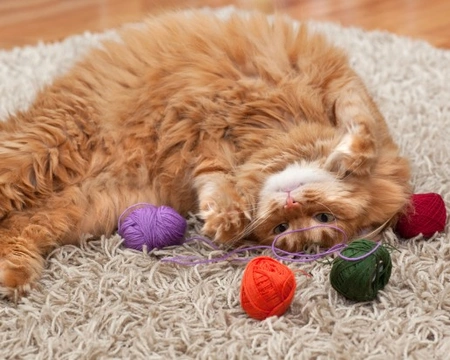Pets
Pets for studWanted petsBreedersAccessories & services
Knowledge hub
Support
Support & safety portal
Keeping an indoor cat happy and active
Indoor cats may have a 'cushy' life, with food on demand, comfy surroundings and not having to face adverse elements, but did you know they do have some specific needs to ensure they live long, healthy and content lives? In addition, indoor cats can often live longer than their outdoor counterparts as they do not face daily dangers such as road traffic, other animals and many diseases.
Even with that in mind, it's not always fun, fun, fun for indoor kitties, which will still have the instincts within them to hunt, scratch and stalk. When you, their owner, do not provide them with the opportunity to do these things, they can become bored, overweight and even depressed.
However, with a little imagination and planning you can keep Tiddles stimulated and your home into a feline friendly one. Need inspiration? Read on......
Keeping an indoor cat entertained is not hard and with a little imagination, everyday objects and things you may never imagine could be used can.
- Bring the outdoors indoors: Make sure your cat has access to a few pots of fresh and growing grass and catnip. The ideal place for them is sunny windowsill. Cats enjoy chewing grasses and they can be beneficial to the health of your cat. Please make sure any plants you have on offer are not toxic to your pets. Place bird feeders near the windows where your cat can sit to watch them.
- Being outside anyway: If your garden space (and budget) allows it, you could even build an outdoor and escape proof run for your cat, complete with high shelves, branches, different levels and perches to climb on and scratch. Make sure the enclosure is safe, easy to clean and built from weatherproof materials. It does not have to be particularly large, think large chicken or bird coop and you will not be far wrong. If your budget or DIY skills will not stretch to building an outdoor run, why not try a cat harness? Like harnesses for dogs, cats harnesses are safe and secure provided you read the instructions and fit them correctly. They usually strap over the chest, shoulders and neck and are padded to ensure a comfy fit. You cat may or may not take to it, so it is a good idea to try it in the house first, without a lead attached. When your cat seems comfortable with it on, try leading your cat, (gently), to the food bowl, or give treats whilst your cat is wearing it. Make it a pleasurable experience for, but importantly, do not force your cat to wear it, and soon you and your cat could be going for walkies in your garden.
- Indoor activates: You should always make sure your cat has a scratching post in the house; otherwise it may turn its attentions to your furniture or curtains! Toys which move or ones which your cat is able to chance are always popular. Scrunched up paper balls and pieces of ribbon at the most basic end of the spectrum are always popular. When not try attaching them to a helium balloon which will move by itself when your cat tugs on it or bats it? Laser pointers are useful as the little red dots can be aimed in all nooks and crannies, and are perfect for pouncing on. Just take care not to shine it directly into your cats' eyes. It is worth rotating toys and periodically introducing new ones to keep your cats interest as much as possible. You could try hiding treats for your cat to find during the day if you are out at work, or try any one of the new toys which she will have to bat along to make treats fall out. 'Fishing' is always popular and simple to do by just filling a shallow bowl with water and placing floatable objects in it such as corks and ping pong balls for kitty to 'fish' out.
- Make your home feline friendly: Try to make your home more natural for your cat - place blankets and cushions on secure shelves. Cats like to be 'high' and enjoy the vantage point from above everyone else. Walkways, ladders and indoor cat 'trees' are all available from pet stores, or you could try making your own.
- Feed twice daily - this helps break up the day or you could even hide some (dry) food around the house so your cat has to hunt for it.
By observing your cat's behaviour in the house, you will probably find yourself inspired to make many changes. You are only limited by your imagination with this one. If your indoor cat sleeps for most of the day, it is probably not tired or lazy, but bored. An inactive cat is also prone to weight gain, which will be unhealthy and make it more prone to illnesses. Interact with your cat, have fun, play and have lots of cuddles and your cat will love you for it!



